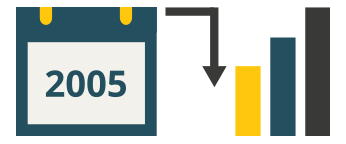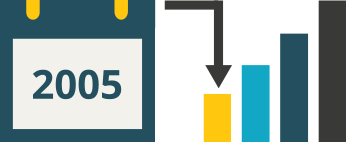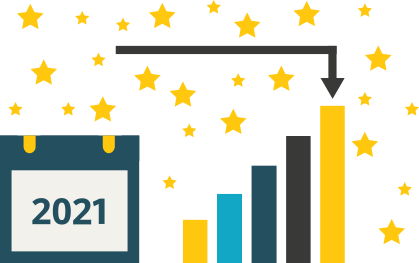
Are Your AdWords Campaigns Stuck in 2005?
24 May 2018Your Google AdWords campaigns are performing OK, right? You’ve researched thousands of long-tail keywords. Created thousands of ad groups. And crafted thousands of ad messages to closely match your keywords.
You’re receiving clicks, and they’re helping to generate enquiries, bookings, and sales. Revenue is coming in, and you’re pretty sure AdWords has played a part. Business is OK, so time to move on, right?
Wrong!
Pay per click (PPC) marketing has evolved since the days of one-dimensional long-tail campaigns, where a successful PPC strategy involved showing thousands of tailored ad messages on Google for thousands of long-tail keywords.
No longer should everyone see the same ad on Google when they search for the same phrase. No longer should ads fail to recognise the searcher’s location, device, time of day, day of week, age, gender, knowledge of their business, relationship with their business, and previous status as a customer.
Welcome to the world of multi-dimensional Google AdWords campaigns. Where there is no such thing as top spot on Google. Where success is no longer battle of the budgets. Where every AdWords dollar is spent wisely. And where your AdWords strategy constantly evolves to meet the changing needs and demands of your business.
How Old Are Your AdWords Campaigns?
How are your campaigns really performing? Are you sitting back on mediocre sales and return on investment? Finding it difficult to keep up with the competition?
Or are you making the most of your limited budget? Pushing the boundaries of what’s possible? Driving your business forward to new frontiers and reaping the benefits?
Let’s find out with a journey back in time.
Stage 1 – 2005

It starts with Stage 1. The basics of a Google AdWords campaign. A starting point for new businesses. The fundamentals of search marketing, but stuck in the last decade.
Strategy: Keyword segmentation
Description: Thousands of tailored ad messages showing for thousands of relevant keywords.
Example: When a 36-year-old parent in Melbourne searches Google for ‘Accommodation in Noosa’, your ad message mentions ‘Noosa’ and ‘Accommodation’.
Results: Lots of wastage, high click costs. Poor visitor engagement, poor conversion. Campaigns running at a loss or only marginally profitable. Business struggling to grow.
If This Is You: Your campaigns are stuck in the past. Time for an upgrade.
Stage 2 – 2012

The realisation that location matters. Where your ads are becoming segmented. Google AdWords wanting to be profitable.
Strategy: Keyword segmentation + location segmentation
Description: The previous stage, plus separate ad messaging for key geographical segments. Clear visibility on how different locations are performing, and which locations can benefit from their own separate strategies.
Example: When a 36-year-old parent in Melbourne searches Google for ‘Accommodation in Noosa’, your ad message mentions ‘Noosa’, ‘Accommodation’, and ‘Escape the Cold of Melbourne’.
Results: Decent click through rates, decent visitor engagement. AdWords spending more closely aligned to conversion by location. Decent campaign profitability and ROI.
If This Is You: You’re neglecting opportunities for higher profitability. Time to cut out the wastage.
Stage 3 – 2015

AdWords personalisation begins. A realisation that people are different. The desire to get more out of AdWords.
Strategy: Keyword segmentation + location segmentation + demographic segmentation
Description: The previous stage, plus demographic bid adjustments and tailored ad messaging aligned to age, gender, and parent status. Measurement process in place to measure and refine demographic performance.
Example: When a 36-year-old parent in Melbourne searches Google for ‘Accommodation in Noosa’, your ad message mentions ‘Noosa’, ‘Accommodation’, ‘Escape the Cold of Melbourne’, and ‘Great Facilities for Kids’.
Results: Huge cost savings by excluding low-performing segments. Click through rate, visitor engagement, and conversion rates look healthy. Campaigns working well and enabling growth of business.
If This Is You: Your campaigns aren’t bad, but there’s room for improvement. Audience strategies will take your campaigns to the next level.
Stage 4 – 2018

Google AdWords for 2018. The standard your customers expect. Google AdWords as it should be today.
Strategy: Keyword segmentation + location segmentation + demographic segmentation + audience intelligence
Description: The previous stage, plus separate campaigns for people who have and haven’t previously visited your website. At least 50 audience segments based on level of engagement, key page views, goal completions, and recency of visit. Audience segments used as bid adjustments, separate dedicated campaigns for key audience segments. Positive and negative audience targeting used to control messaging for users in multiple segments.
Example: When a 36-year-old parent in Melbourne searches Google for ‘Accommodation in Noosa’, your ad message mentions ‘Noosa’, ‘Accommodation’, ‘Escape the Cold of Melbourne’, and ‘Great Facilities for Kids’. Because the user recently visited your website, searched for availability and rates in 12 months time, then left without making a booking, your ad message mentions ‘Early Bird Special! Book Now For 2019 & Save 20%! Coupon Code EARLYSAVE20’.
Results: High click through rates, high return visits. Sales funnel clearly established, visitor engagement and conversion at all-time high. AdWords ROI at record levels, business growing steadily.
If This Is You: You’re meeting the expectations of today. Customers are generally happy with your marketing and think your business is up to date. Time to plan for 2019 and beyond.
Stage 5 – 2021

Google AdWords of the future. Above and beyond customer expectations. A truly helpful and enriching search experience.
Strategy: Keyword segmentation + location segmentation + demographic segmentation + audience intelligence + business intelligence
Description: The previous stage, plus separate campaigns for previous customers, groups of previous customers, and people in your database. Tailored ad messaging based on your previous relationship with that searcher, how they interacted with your business, what they purchased or booked, how recently, and how frequently. Separate ad messaging for regular customers, and people who signed up to your newsletter. Separate strategy in place for people who made an enquiry but haven’t yet converted, intelligence from the enquiry used to personalise your ad message to that user. Time-decay campaigns set up to display different search ads based on how recently the user became a customer, or at pre-defined periods such as every 12 months after original sale. Seamless flow of data from Google AdWords and Google Analytics to a CRM such as Salesforce, and vice versa back to AdWords and Analytics. Process in place to measure, refine, and expand the AdWords strategy to respond to changing business needs.
Example: When a 36-year-old parent in Melbourne searches Google for ‘Accommodation in Noosa’, your ad message mentions ‘Noosa’, ‘Accommodation’, ‘Escape the Cold of Melbourne’, and ‘Great Facilities for Kids’. Because the user previously booked a 7-night deluxe suite last year, your ad also mentions ‘Deluxe Suite Special – Stay 7 Nights Pay For 5! Free Breakfast & Late Checkout for Previous Guests’. When the user searches Google next year for themes related to Noosa accommodation, holidays, or flights, your ad appears, offering the searcher a free room upgrade and complimentary welcome hamper to reward their loyalty.
Results: Click through rates, conversion rates, and ROI through the roof. Wastage from AdWords almost non-existent. Customers happy, high repeat business. Business expanding into new markets.
If This Is You: Your campaigns are world-class and breaking new boundaries. Your competitors can’t keep up! You’re winning awards for innovation, and the sales keep pouring in. Keep it up – you’re on a path to success.
You Don’t Need A Big Budget
To be successful with AdWords. Rather than showing:
-
the same ads for mobile and desktop searchers
-
the same ads for Melbourne and Sydney searchers
-
the same ads for male and female searchers
-
the same ads for 18-24 and 65+ searchers
-
the same ads for evening and weekend searchers
-
the same ads for previous website visitors, and
-
the same ads for your previous customers
Wouldn’t you prefer a more tailored and segmented AdWords strategy? One which provides potential customers with a more the same ads experience? Which makes the most of your limited budget and maximises return on investment?
AdWords is no longer battle of the budgets
Large or small, niche or boutique, there is no excuse for an under-performing AdWords strategy.
-
Budget of $500/month? Make it work for your business.
-
Budget of $5,000/month? Make it work for your business.
-
Budget of $50,000/month? Make it work for your business.
Get more sales, lower your costs, and boost your profits with an AdWords strategy built on data. Make each dollar work harder for your business and reap the benefits for years to come.
